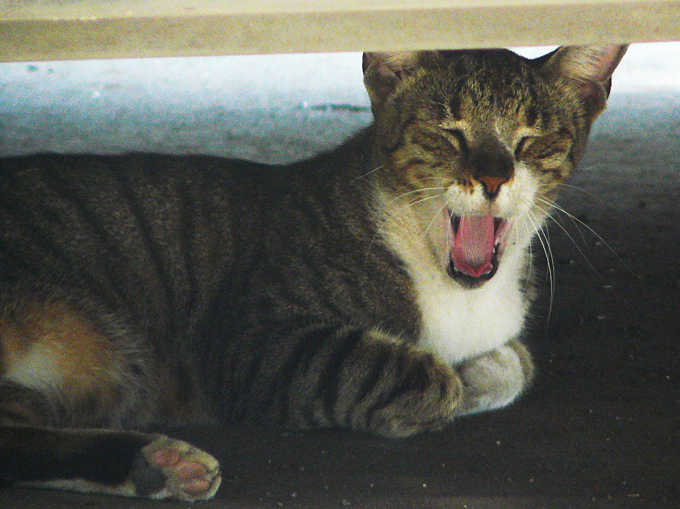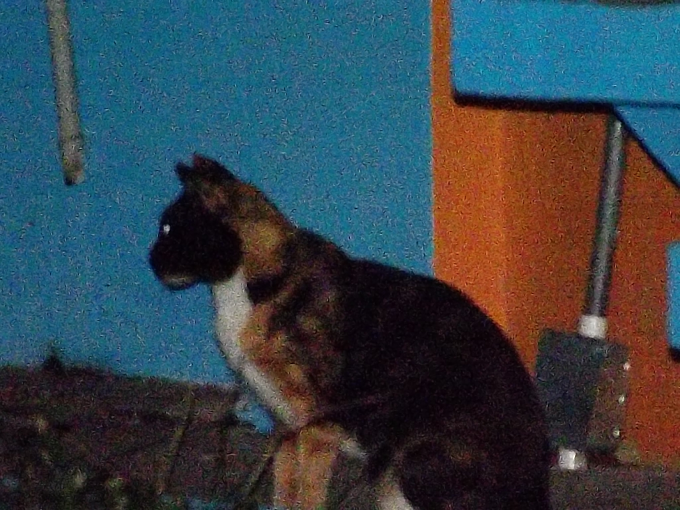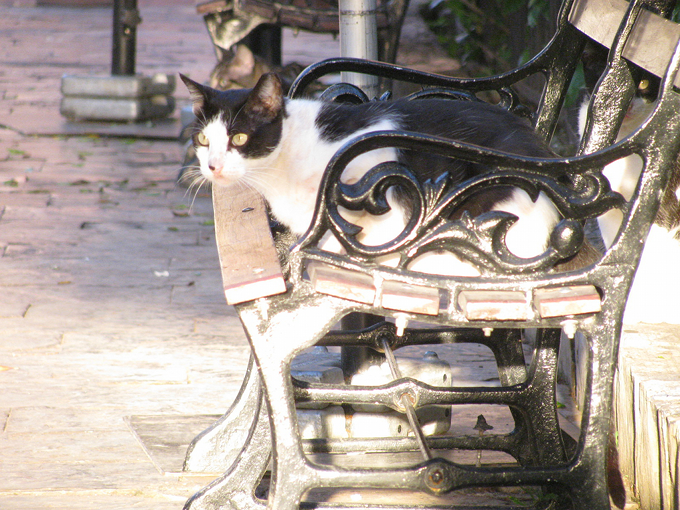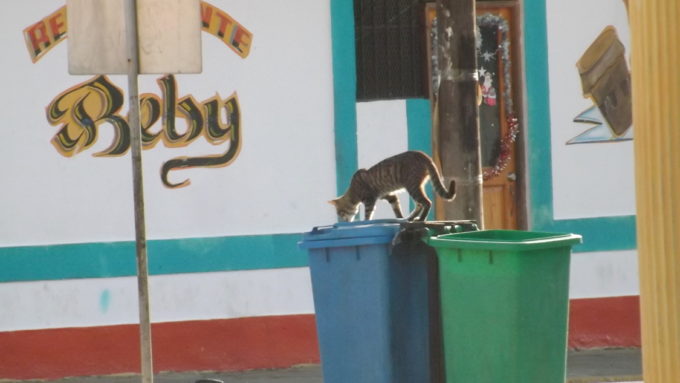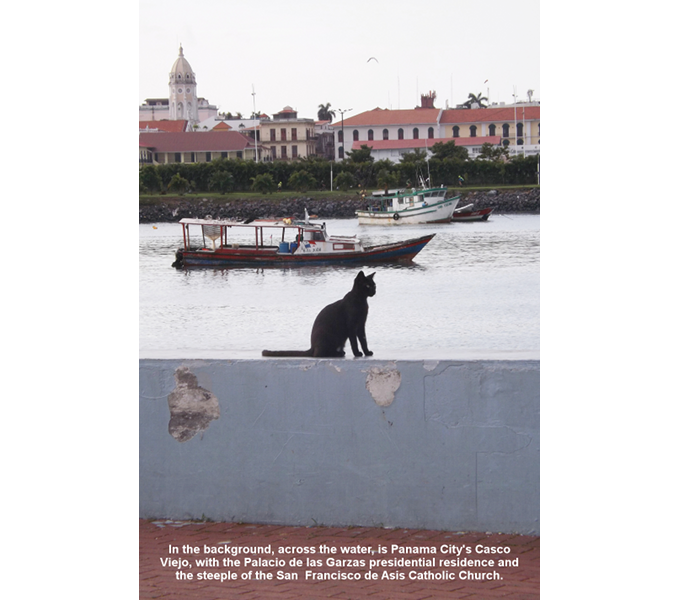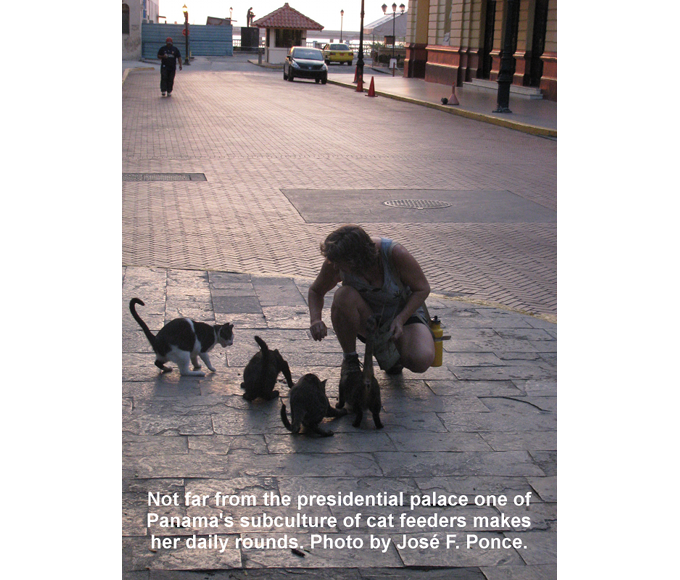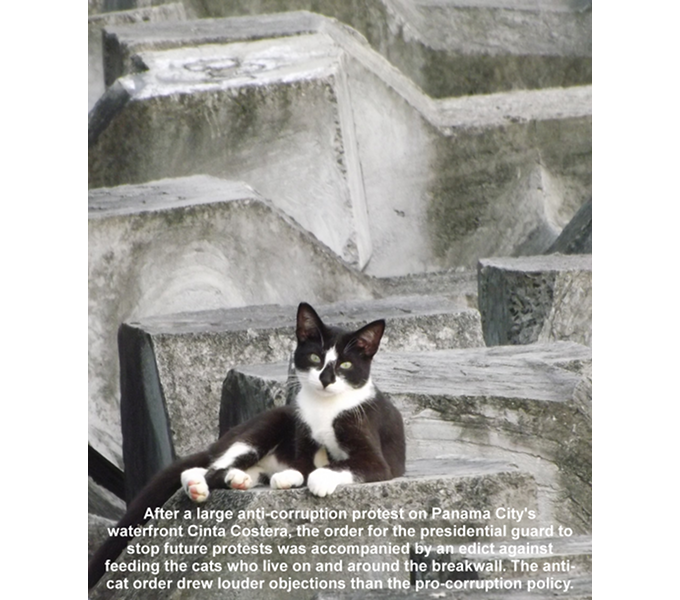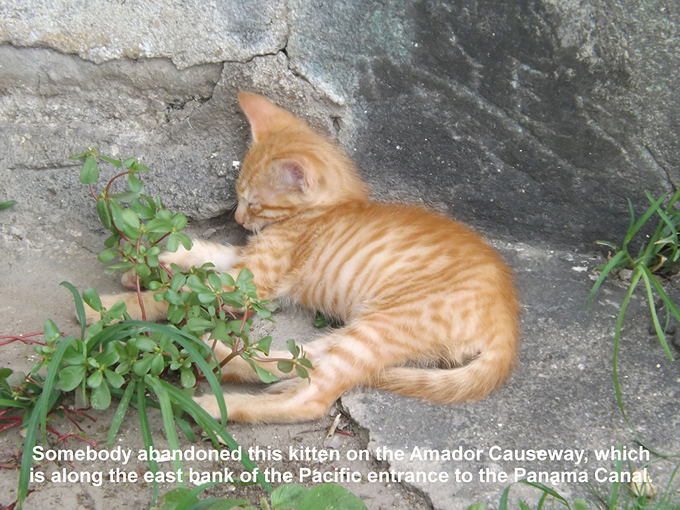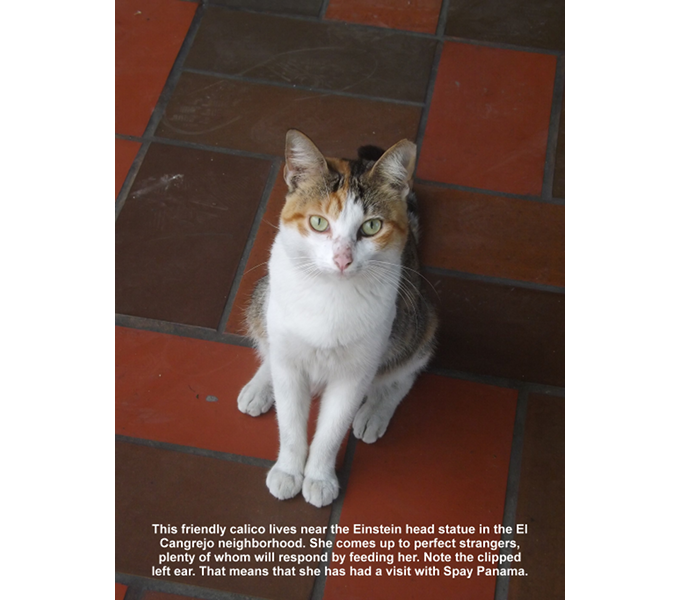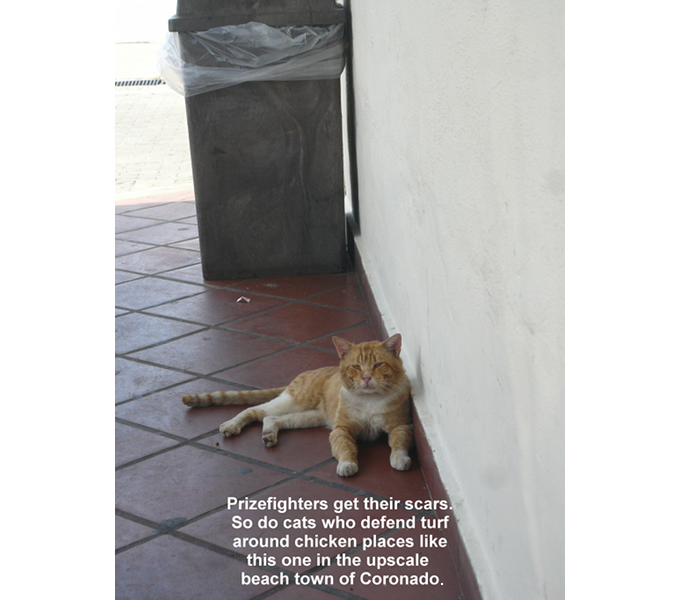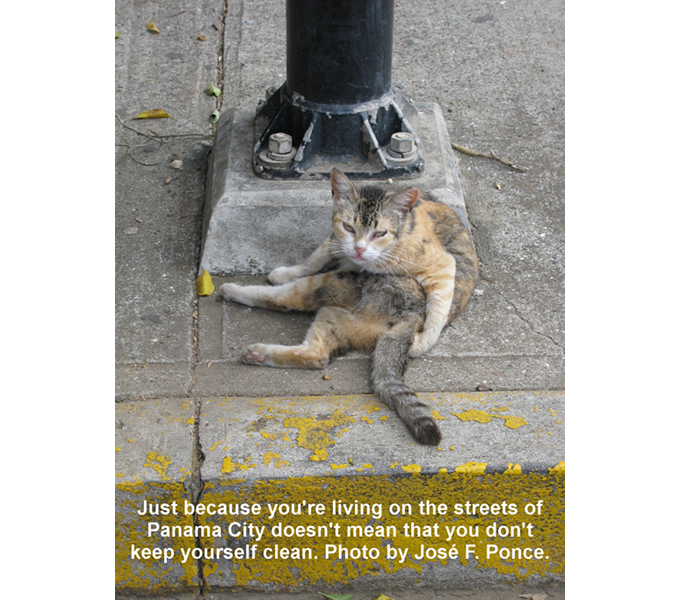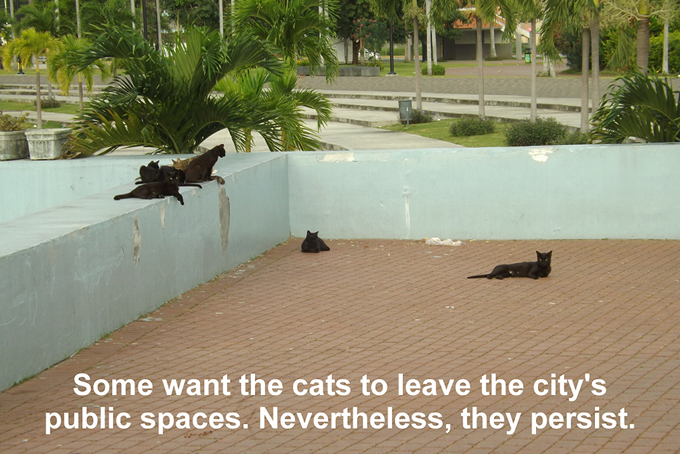City cats
by Eric Jackson, some photos by José F. Ponce as noted
Feral cats are an exotic species in the United States. With numbers in the millions, these animals are recognized as one of the most widespread and serious threats to the health and integrity of native wildlife populations and natural ecosystems. Feral cats present special challenges for wildlife managers because their negative impacts are poorly understood by the public. Feral cats and other exotic species have become accepted as part of the environment and considered “natural” by many people. Advocacy groups promote their continued presence and few policies and laws deal directly with their control.
California Department of Fish and Wildlife
The cats just sort of domesticated themselves. People today know that you can’t keep a cat inside, and 10,000 years ago in the Fertile Crescent you couldn’t just shut the window.
Carlos Driscoll
US National Cancer Institute geneticist
Over time, plants and animals that once thrived on our continent have been pushed to the brink. We need to step in, for their sake and for ours. That means humane culling of one of our wildlife’s worst enemies — feral cats.
Greg Hunt
Australia’s Federal Minister for the Environment
Feral cats live very closely with humans, and depend on humans for food. A small number of feral cats are a useful addition to any human dwelling area. Cats provide a very effective means of vermin control. Rats and mice are not problems when there is a feral cat community. Many people grow fond of the ‘regular’ feral cats in an area. They do not need much food — often leaving out household scraps is enough to sustain them. Feral cats rarely carry any disease, which might put human health at risk. Most people would see a small, controlled population of feral cats as a positive, beneficial aspect of a housing estate.
The Cat & Dog Protection Society of Ireland
Particularly among those of us who have been raised in the faith of great world powers that are now in decline or at least in serious trouble, there are nihilistic ways of thinking out and about in the world. Every religion that is fervently embraced is rejected by more unbelievers than it has adherents and is increasingly subject to strident attacks. So do we reject faith in favor of reason? Do we pay attention only to “objective journalism?” Do we only believe in “scientific truth?” Do we, while straying from the grammatically correct distinction between one medium and several media, reject all journalism because “the media” — this singular phenomenon as popularly perceived — “is” controlled by a cabal of oligarchic manipulators whose intention is to deceive? Do we reject science because, “as everybody knows,” climate change is a hoax promoted by one-worlders like George Soros and Al Gore and endorsed by the great majority of scientists, who have been bribed or intimidated by an establishment that has let it be known that they won’t get grants to study anything if they don’t go along? You can find left and right variations on such conspiratorial themes, and certain proofs that much of the world actually works that way.
Need we go to Oriental philosophy to get our proper perspective on objective journalism? Take if from the late Chinese revolutionary and despot Mao Zedong, or from Chinese-American reporter and anchorwoman Joie Chen, in the different frameworks in which they respectively put it: “completely objective journalism” is myth. Yes, there is such a thing as truth, or “objective reality” if you want to couch the concept in Marxist jargon. But which facts are important — or to put it into the liberal capitalist formulation of The New York Times, are what constitute “news that’s fit to print” — is a matter of opinion. The Times, Fox News, Russia Today, Al Arabiya, TeleSur, Ha’aretz and Der Spiegel may all be populated by journalists who want to tell the truth, but they are looking at the world from different perspectives and will not all be reporting the same stories in the same way on any given day.
And can’t similar things be said about science? Set aside the insulting stereotypes that are at war with the open but skeptical minds of most worthy scientists. Set aside the scandalous existence of “experts for hire” who will testify to just about anything if the price is right. Discount all that, but can’t we still find something subjective in the particular questions that pique the interest of an individual scientist? Without getting into conspiracy theories, can’t we still recognize that there are institutional biases — plural — in the determination of which scientific inquiries get financial backing? Then when you get to the intersections of science and public policy, you are likely to find that no single scientifically verifiable or refutable assertion of fact answers a broader policy question. Public policy matters are typically multidisciplinary, often involving series of inquiries in separate fields of science, plus historical and cultural factors. The assertion of single scientific fact as determinative of a policy question, no matter how well proven it might be, is usually an exercise in lazy and dogmatic thinking. Even lazier and more dogmatic is the denial of well founded science based not on any reason to doubt but because it conflicts with one’s political position or perceived economic interests.
Panama City and most of the provincial towns are full of cats that nobody “owns.” Some are strays, cats that were once socialized into a human household and were then abandoned or otherwise “lost.” Most are feral cats that may have lived all of their lives around people and probably in one way or another depend on human civilization for their sustenance, but they have never been pets and unless they are very young kittens will resist being socialized as such.
Cats are an exotic invasive species in Panama. So are dogs. So are mango trees. So are a lot of the pigeons and parrots found in the trees of our city parks. So are human beings. Does the definition resolve any public policy debate about what should be done about the urban feral cat populations that we find in Panama? Probably not, but it at least ought to be one of the facts that informs such a discussion.
We now know from genetic research that domestic cats diverged from Near Eastern wildcats, a species found in the Fertile Crescent around the Tigris and Euphrates Rivers. The oldest archaeological evidence of domestic cats living with people is from Cyprus and dates back some 9,500 years. It is presumed that with the rise of agricultural civilization about 10,000 years ago in the ancient Midldle East, domestic cats found it advantageous to move in with people and farmers found it useful to keep cats around.
The alliance between people and dogs is much older, most probably going back to cooperative relationships between pre-human hominid hunters and gatherers and wild dogs, most particularly certain species of wolves. People and dogs are both social animals, hunt well together and tend to become socialized to protect one another. But the relationship between people and cats is younger, arose in a different economic context and was shaped by distinct features of the feline personality.
The partnership between people and dogs was in large part an aggressive alliance, a joint assault on wild animals that both people and dogs wanted to eat. The defensive part of this partnership probably soon followed in form of protecting campgrounds or shelters from other wild animals, the defense of habitats that people were able to more effectively conquer or hold with canine assistance.
Cats walked into human society at a different point when other creatures were also coming around to visit people, and most particularly their granaries. Rats and mice will eat an awful lot of grain is they are allowed to do so, and can contaminate what they leave behind — via droppings, urine or arthropods — with microbes that can be quite harmful to people. Back when agriculture started in that part of the Middle East people didn’t know about microbes, but surely they noticed that the cats that came visiting liked to hunt the rodents that came to eat their food. That these strange, independent hunters could also become quite affectionate with the people whose homes they shared cemented the bonds of a great alliance. The cohabitation of cats and people spread and it wasn’t all that long before the neighbors in Egypt considered cats to be a divine species.
People and dogs invaded the Americas together, coming across an Ice Age land bridge where there is now the Bering Strait and from what the archaeological and paleontological records suggest, together hunting mammoths and other large animals to extinction. The human and canine exotic species invasion spread down through the Americas but precisely when and under what sorts of circumstances it first came through Panama may only be inferred. Sea levels were much lower then and it is believed that early migrants made their way down coastal areas that are now underwater. The oldest human habitations encountered in South America are substantially older than the oldest human finds in Panama. The earliest human traces that archaeologists have found on the isthmus are of people living with dogs and doing a bit of hunting, a bit of gathering, a bit of agriculture and a bit of fishing.
Cats came to Panama with another, later exotic species invasion, on ships with largely Spanish crews. Yes, a famous Italian explorer came by these shores early in that invasion, and had a bad time of it here. Records suggest that North Africans were also among the early Spanish crews. That would make sense if one knows the history of Spain, large parts of which were occupied by Arabs for more than 700 years and which still occupies a small part of North Africa.
The Spanish Inquisition was largely about getting everyone in the Spanish Empire to suppress and deny any Muslim or Jewish influences. Some of these proved rather impossible to hide. Earlier, when Islam broke out of the Arabian Peninsula and spread all the way to Spain on one side and eventually to the Philippines on the other, a lot of prior cultures were overrun and in part incorporated into Muslim ways but then, too, it was religously correct to deny or minimize pre-Islamic cultural phenomena. But on its way to Spain the rapid expansion of Islam incorporated Egypt, with its cultural affinity for cats. Argue what you will about who borrowed what from whom, but the norm in Arab culture became that cats are Allah’s wonderful creatures and proper members of a Muslim household, while dogs are disgusting, dirty things, not all that much higher in the order of things than pigs. And when a Spain that had been steeped in Arab influence that it desperately wanted to deny invaded Panama, the Spaniards came with vicious military dogs, on ships where cats were kept as pets and to keep rodents out of the ships’ food supplies. The Spanish war dogs couldn’t take Panamanian conditions and failed to leave much of a mark on the existing canine population, but domestic cats thrived on the isthmus.
Cats were far from the only exotic species that invaded Panama as part of the European Conquest. Many plants and animals came here from many places. Two of the more noteworthy exotic mammal species that came were horses and cattle. Ecologists will often talk about the destructive impact of cattle grazing, but far less frequent is a discussion about cattle as an invasive species that must be extirpated. In parts of the western United States, however, control of feral horses on federal lands is a public policy issue, with those who love the “wild” mustangs and those who don’t.
Then there were other mammals, raised as neither pets nor servants nor sources of meat, who came to Panama with the European invaders. These were the rats, two species in particular.
One of these, the Norway rat or brown rat — Rattus norvegicus — is believe to have originally come from northern China. This a relatively large rat as far as the muriods go, and it likes to burrow into the ground, or into structures made by people. It is the dominant rat species in Europe and much of North America and is present on all continents except for Antarctica. If you see rats scurrying down a Panama City alley, they are probably Norway rats.
Also present in Panama, and far more prolific here, is the black rat, Rattus rattus. These creatures, with smaller bodies but longer tails than the Norway rats, have been an especially terrible scourge of humanity. Thought to have originated in Southeast Asia, they spread through India to the Middle East and then into the Roman Empire. They were the reservoirs of the Pasteurella pestis microbes that were transmitted to humans via the bites of fleas which live on the rats to cause bubonic plague. In the middle of the 14th century Europe’s economic, social, political and religious orders were disrupted by the Black Death, a series of bubonic plague outbreaks that killed at least one-quarter of the European population.
In Panama the black rat is the most widespread rodent species. In urban settings it’s a climber found on rooftops and scurrying around on false ceilings. In rural settings it’s arboreal and a major agricultural pest for those who grow orchard crops.
The black rat is, however, not the most numerous of Panama’s 54 known rodent species. That distinction goes to the short-tailed cane mouse, Zygodontomys brevicauda, a species indigenous to the region, also an agricultural pest and also at times a disease vector.
Thus if domestic cats are an invasive exotic species, they are not the only ones on the scene. After they have become established parts of many environmental niches, the removal of feral cats will have a number of environmental effects, one of which is likely to be a spike in local rodent populations. There will also, however, be less predation of birds, lizards, snakes and other animals. Domestic cats, like certain people and unlike their distant wild cousins who are indigenous to Panama, will hunt for the fun of it. How serious a toll taken on wildlife by feral cats — and by pet cats who are fully domesticated members of human households who go out to hunt or who terrorize the geckos that populate most Panamanian homes — is a matter worthy of serious scientific debate.
But how ferocious, unscientific and even anti-scientific the debates can get!
Three ornithologists from the Smithsonian Migratory Bird Center and Towson State University studied the survival rate of gray catbird fledglings in three locales of the Maryland suburbs of Washington DC. There were 69 birds counted, of which 42 did not survive to adulthood. The scientists observed six of the birds being killed by cats, and inferred from circumstances that anther three had fallen victim to feline predation. Other known predators killed 10 of the juvenile birds, while 14 succumbed to unknown predators. Predation was not much of a problen in one of the three venues.
So a press release by the Smithsonian National Zoo spun it in this way: “Sadly, predators were responsible for 79 percent of the mortalities of the juvenile catbirds in the study. Of those deaths, nearly half were attributed to cats….” But Alley Cat Allies, a grouip that is for spaying and protecting feral cat populations, replied with its “Breaking Down the Bogus Smithsonian Catbird Study” online post: “The number of deaths attributable to cats is 9 birds out of 69 — or 13% — not 47%.” The pro-cat group argued that the scientists’ work “is a limited study that cannot be extrapolated to represent the complex cat-bird dynamic nationwide” and that “much more disturbing, however, is how this data has been manipulated to malign cats and used widely to dredge up a false and counterproductive debate.”
Cats are predators with respect to many species of birds? How can anyone who knows cats deny it? How serious the predation problem would be surely depends on the species, the characteristics of the locale and the size and concentration of the cat population in that place. The study is what it is and would seem to call for more research in more places, with respect to more species of birds and making more measurements of the environmental contexts. To dismiss it out of hand or to exaggerate its findings both seem to be the sorts of dogmatic responses that characterize so much public discourse about so many different subjects in the United States these days.
But consider how intellectually lazy the “pro-science” argument that the study indicates that feral cat populations ought to be removed can be. Set aside all of the beside-the-point counter-arguments about how loss of habitat due to human actvities takes a worse toll on the birds. Look at the other variables of the public policy problem, first of all the realities about cats.
This issue was presented to another branch of the Smithsonian Institution, in Panama. The Smithsonian Tropical Research Institute — STRI — maintains its headquarters in Ancon on the site of the old Tivoli Hotel, within eyesight of Panama’s legislative palace. Part of its grounds is a tiny forest fragment with both native and exotic species of trees, a relatively serene spot in a loud and chaotic city that attracts birds and is home to ñequis — indigenous forest rodents whose English name is agoutis but in most Panamanian English conversations will referred to by their local Spanish name, often with an anglicized pronunciation. On the other side of a busy roadway that’s hazardous to cats, people and other living things, there are the grounds of the legislative palace and an adjacent little urban park which together are home to a feral cat population, plus the hardscrabble and densely populated urban neighborhoods of San Miguel and Hollywood that also have feral cats. (There is nothing glamorous about the latter place.) “Safely” on STRI’s side of the road and down a hill from the little forest fragment there is a partially residential area that includes the National Police’s Directorate of Judicial Investigations complex. There are people who live or work in the area who feed the feral cats. Go another direction, uphill, from STRI and there are churches, government offices, courts, a cancer hospital and residences before one gets to Ancon Hill National Park, a magnificent tropical forest fragment that’s home to many wild species and one of the crown jewels of Panama’s capital city.
STRI’s Ancon headquarters had feral cats and went to Spay Panama, asking for the group’s assistance to remove the felines.
Understand about STRI: set in a country with one of the world’s very worst educational systems, it’s world-class research and educational institution, heavily weighted toward biological investigations but also home to geologists, anthropologists and scientists in other fields.
Spay Panama’s founder and director, Patricia Chan, is a retired financial planner. Not just an ordinary one. Under the US administration of the Panama Canal that ended on the last day of 1999, she was director of financial planning for the canal. The woman knows mathematics and she knows and loves cats, but she’s not a scientist in the sense that most of the people who work at STRI are.
However, it fell to Pat Chan to explain some things about the nature of feral cat populations to the scientists at STRI. Take all of the feral cats away from STRI’s little forest fragment in Ancon — “put them to sleep” to use the polite American term for a practice to which most Panamanians object, find them another home or whatever, but just get rid of them — and what will you accomplish? Sooner rather than later other feral cats from surrounding areas will move in and claim the niche as their own and the same problem will arise.
It’s much better, Chan argued, to capture the feral cats, neuter them and put them back to from whence they came. They will hold the territory against other cats, but won’t be adding to the population problem. STRI, whose staff includes cat lovers and those who would prefer a world without domestic cats, took her advice.
The capture, neuter and release strategy for dealing with feral cat populations is gaining adherents in many places around the world. In many places it faces bitter opposition.
Set aside traditional Humane Society operations that have vested contractual interests in the capture and kill if not adopted approach — with respect to feral cats it’s almost always a death sentence because these animals don’t want to be held by people or kept indoors. Set aside those who for whatever emotional reason just don’t like cats. Set aside the uninformed or misinformed. There can be reasons for opposing the maintenance of a feral cat population in a given area, spayed or not.
In some places there are wildlife species that have had no natural predators and are incapable of withstanding the ravages of hunting by feral cats. This is probably more true in Australia than on any other continent, and is certainly true on some small islands.
Feral cats carry diseases, it is argued. The one most often cited is toxoplasmosis, infestation by the internal parasite Toxoplasma gondii. Cats, dogs and other animals can carry it and humans can catch it too. Most human infections are just a nuisance that can be easily treated, but undetected and untreated for long enough in a child it can cause some serious damage, including blindness. But how are most human infections contracted? Not from exposure cats but by the improper handling of food.
It’s not a healthy thing for children to be playing in a sandbox that cats — pets or feral — may use as a litterbox. But forget about trying to train, eliminate or repel cats. Every proper children’s sandbox has a cat-proof cover for when it’s not in use.
So is there a middle path between denial and extreme measures that don’t actually work? Chan thinks that there is. “Overpopulation of cats is definitely a threat to public health. Cats in dumpsters are more prone to internal and external parasites and yet they help humans by keeping the rodent population under control, especially around dumpsters.” Through the capture, neuter and release approach she seeks to gradually reduce feral cat populations and the problems that they can cause. Meanwhile, any cat that comes through Spay Panama is treated for parasites and vaccinated against a number of diseases.
Perhaps the best showcase for what Spay Panama has been doing is at Plaza Francia, in the capital’s historic Casco Viejo. It’s adjacent to the French Embassy, not far from the presidential palace. Not too many years ago it was home to a large population of underfed and unhealthy cats who would compete for the food that kindly tourists and regular cat feeders had to offer. A lot of the males bore marks from fights with other cats. There are still feral cats prowling Plaza Francia, but after years of Spay Panama’s attention there are fewer of them and those who remain on the whole look a lot healthier.
